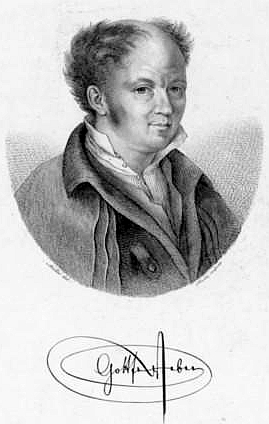Gottfried Weber on:
[Wikipedia]
[Google]
[Amazon]
 Jacob Gottfried Weber (March 1, 1779 – September 21, 1839) was a prominent German writer on music (especially on music theory), composer, and jurist.
Jacob Gottfried Weber (March 1, 1779 – September 21, 1839) was a prominent German writer on music (especially on music theory), composer, and jurist.
''Versuch einer geordneten Theorie der Tonsetzkunst'', Volume 1
(Mainz: B. Schott's Söhne, 1832). *
Volume 2
(Mainz: B. Schott's Söhne, 1832). * Gottfried Weber
''Theory of Musical Composition'', trans. James F. Warner
(Boston: Wilkins, Carter and Co., 1846).
 Jacob Gottfried Weber (March 1, 1779 – September 21, 1839) was a prominent German writer on music (especially on music theory), composer, and jurist.
Jacob Gottfried Weber (March 1, 1779 – September 21, 1839) was a prominent German writer on music (especially on music theory), composer, and jurist.
Biography
Weber was born atFreinsheim
Freinsheim (; Palatine German: Fränsem) is a town in the Bad Dürkheim district in Rhineland-Palatinate, Germany. With about 5,000 inhabitants, it is among the state's smaller towns. It is also the seat of the like-named ''Verbandsgemeinde'', a ...
. From 1824 to 1839, he was the editor of ''Cäcilia'', a musical periodical published in Mainz
Mainz () is the capital and largest city of Rhineland-Palatinate, Germany.
Mainz is on the left bank of the Rhine, opposite to the place that the Main joins the Rhine. Downstream of the confluence, the Rhine flows to the north-west, with Ma ...
, which influenced musical thought in Germany during the early Romantic era
Romanticism (also known as the Romantic movement or Romantic era) was an artistic, literary, musical, and intellectual movement that originated in Europe towards the end of the 18th century, and in most areas was at its peak in the approximate ...
.
His most important work is his ''Versuch einer geordneten Theorie der Tonsetzkunst'' ("Theory of Musical Composition") (Mainz: B. Schott, 1817–21), which introduced several concepts that have since become important in the study of music theory. In this work, Weber develops the idea of "Mehrdeutigkeit" (that is, "multiple meaning"), a term initially introduced by Georg Joseph Vogler. Weber's "multiple meaning" refers to individual tones and harmonies, based on their context in a piece of music. For example, a C major triad may serve as I in C major, IV in G major, V in F major, etc. "To analyze a chord, a theorist must ask not only 'What notes are in it?' but also 'How is it behaving in the harmonic progression?'" (Thompson); see diatonic function. In the same work, Weber also further develops Vogler's idea of Roman numeral designations applied to chords. Unlike Vogler, Weber implements upper and lower case symbols to show not only the position of each chord related to the scale degree upon which it is built, but also the quality of each chord, i.e. major, minor, diminished, etc. Weber's Roman numeral system of analysis is in wide use in universities all over the world today to varying degrees, albeit with some modifications.
Weber's ''Theory of Musical Composition'' was the first work on music theory to be translated into English for publication in the United States (transl. by James F. Warner, Boston: Oliver Ditson, 1846).
He died in Bad Kreuznach.
See also
* Difficile lectu (Mozart)#First performance—a tale Weber told about Mozart in the pages of ''Caecilia''.References
* Jairo Moreno: ''Musical Representations, Subjects, and Objects'' (Bloomington, IN: Indiana University Press, 2004), . * * David M. Thompson: ''A History of Harmonic Theory in the United States'' (Kent, OH: Kent State University Press, 1980), . * Gottfried Weber''Versuch einer geordneten Theorie der Tonsetzkunst'', Volume 1
(Mainz: B. Schott's Söhne, 1832). *
Volume 2
(Mainz: B. Schott's Söhne, 1832). * Gottfried Weber
''Theory of Musical Composition'', trans. James F. Warner
(Boston: Wilkins, Carter and Co., 1846).
External links
* 1779 births 1839 deaths 19th-century classical composers 19th-century German composers 19th-century German male musicians German male classical composers German Romantic composers German music theorists {{Germany-musician-stub